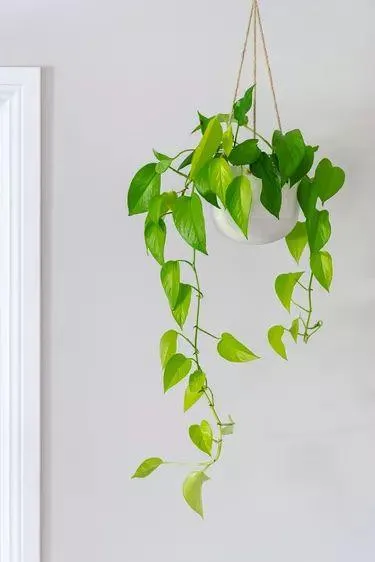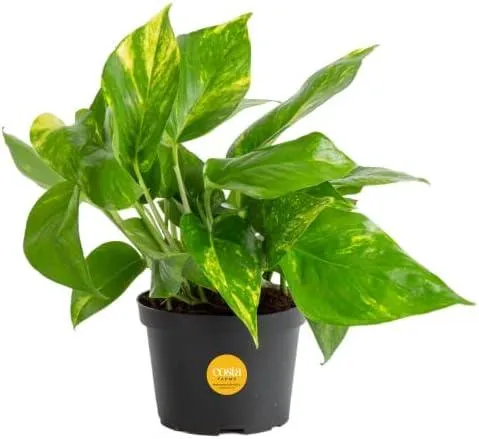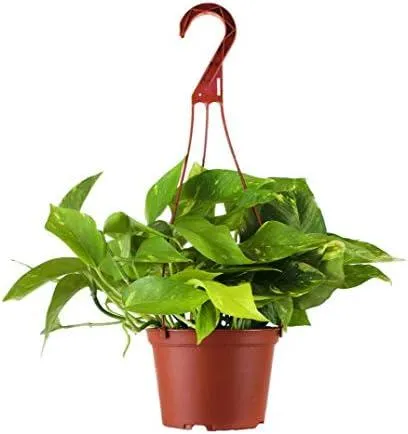A Complete Guide to Growing Pothos Indoors
If you’re looking for an easy-care houseplant that adds lush greenery to your home, look no further than the pothos plant. Commonly known as devil’s ivy, golden pothos is one of the most popular hanging indoor plants. Its trailing vines, heart-shaped leaves, and ability to thrive in low-light conditions make it an ideal choice for beginning plant parents. In this in-depth guide, I’ll answer all your questions about caring for a hanging pothos as you embark on this plant parenthood journey.
Understanding Pothos Plant Care Needs
Pothos is one seriously tough plant. From my experience growing all sorts of houseplants, pothos is hands-down one of the most forgiving. It just kind of does its own thing and hangs out. Basically, as long as you don’t totally neglect your pothos, it’ll survive. But to keep it looking its luscious best, there are a few care tips to follow.
- Light: Pothos thrives in medium to low light conditions. It can tolerate darker spots but may grow more slowly. South-facing windows generally work great. Mine has kind of survived in a east-facing window but it’s not as full as my others.
- Water: Allow the soil to dry out between waterings. You can tell it’s thirsty when the top 1-2 inches of soil are dry. Overwatering causes yellowing leaves. I’d go kind of easy on the water at first until you learn its needs.
- Humidity: While pothos can tolerate low humidity, it appreciates occasional misting. If your home is super dry in the winter, place the plant on a pebble tray with water. Its leaves may yellow if humidity is too low.
- Fertilizer: Feed your pothos monthly in the spring and summer with a balanced houseplant fertilizer mixed at half strength. It sort of gets picky if it’s soil isn’t amended regularly.
- Temperature: Pothos does best in temperatures between 65-80°F. It can tolerate brief spells near a drafty window in cooler months but avoid freezing temps. Bring it inside if there’s a chance of frost.
Follow these basic care steps and your pothos will thrive virtually forever! Kind of amazing when you think about how hard we sometimes try to kill plants. But pothos just keeps on thriving despite our mistakes.
Choosing the Right Spot for Hanging Your Pothos
When deciding where to hang your new pothos, start by assessing the light conditions. As mentioned earlier, pothos does well in medium to low indirect light. However, it sort of adapts to whatever light you give it and can even handle lower light. Here are some top hanging spots in the home:

- Near an east- or west-facing window. It’ll get nice morning or afternoon sunlight that way. Just be sure it’s not in direct rays.
- Abovekitchen cabinets where it can get reflected light. Pothos cleans the air as it hangs out in the hub of your home. Win-win!
- In a bathroom to take advantage of the humidity. Hang it near your shower or use a pebble tray underneath. Its leaves may grow larger here.
- Along a stairway railing to add a architectural element. Trailing vines look really cool cascading down.
Try to keep your pothos out of direct sunlight, which can scorch its leaves. But basically any spot with indirect light will work. You’ll figure out through trial and error what environment makes it happiest. No stress if you need to rearrange – pothos is super adaptable like that.
Getting Your Pothos Situated in its Hanging Planter
Now for the fun part – putting your pothos in its hanging planter! There are a few different ways to go about this. Here are the basic steps:
- Start with a planter that has a saucer or way to catch drainage. Terra cotta or plastic works well. Make sure it has holes for excess water to escape.
- Add a layer of rocks, gravel, or charcoal at the bottom to promote drainage and prevent soil from washing out. About 1-2 inches deep does the trick.
- Fill the rest with potting mix suitable for hanging containers. I like fox farm ocean forest or miracle gro indoor potting mix. Pack it down lightly as you fill.
- Remove your pothos from its nursery pot. Try to keep as much of the root ball intact as you can. Gently tease apart any circling roots if needed.
- Plop the root ball in the center of the planter. Backfill around the edges with extra soil until it’s level with the rim. Firm it down with your fingers.
Ta-da, your pothos is all set! Give it a good water to settle the soil. Then hang it up and watch as those vines start trailing down before you know it. So amazing how fast pothos grows once it’s established. Your space will feel instantly lively.
Propagating Clippings for More Pothos
Here’s a fun tip – once your pothos is established, you can take clippings to start whole new plants! Pothos propagate incredibly easily in water or soil. All you need are stem cuttings with at least one set of leaves. Remove the bottom leaves so just the top set remains. Then follow these basic steps:

- Place the cuttings in a jar or container filled with water. Make sure the nodes are submerged but leaves are above the surface.
- Change out the water every 5-7 days to keep it fresh. Roots will start growing from the nodes within 2-4 weeks as long as it gets indirect light.
- Once you see roots 1-2 inches long, it’s ready to pot up! Use a well-draining potting mix and water thoroughly. Voila – an instant new pothos!
You can also propagate cuttings directly in soil. Just stick the stem end down about 1/2 inch deep and keep the soil lightly moist. Either method works perfectly. Pretty soon you’ll have pothos vines spilling everywhere and lots to share. No way to really kill these things!
Dealing With Pothos Pests and Problems
Like basically any houseplant, pothos is susceptible to the occasional pest. But don’t fret – problems are pretty rare with proper care. Here are some potential issues and how to address them:
- Spider mites: Tiny spider-like pests that cause stippling on leaves. Wipe down both sides of leaves with a damp cloth. Spray neem oil weekly as a preventative.
- Mealybugs: Fluffy white bugs that secrete honeydew. Wipe affected areas with isopropyl alcohol on a Q-tip. Isolate plant until gone.
- Yellow leaves: Too much or too little water, low humidity, or not enough light. Adjust care and trim off affected foliage. It should bounce back.
- Brown tips: A sign of mineral buildup from hard water or over-fertilizing. Flush pot thoroughly and decrease frequency of fertilizer.
Most issues are easily resolved. Pothos is pretty tough and resilient. With some TLC, it’ll withstand bugs and thrive no problem. But if you seem to be struggling, no shame in pruning it back to the soil and starting over. Pothos always bounces back stronger.
Transforming an Unruly Vine Back into a Bushy Plant
One fun garden-type hack is transforming a huge, trailing vine pothos back into a compact, full plant. This is great if it’s gotten overgrown or you want a new look. Here’s what to do:

-
Can a pothos hang outside on my patio?
Basically a pothos can hang outside, but it needs some protection from direct sun. Place it in a spot with partial shade. At the same time, watch out for frost – bring the pothos indoors if freezing temps are predicted.
-
How often should I water a hanging pothos?
Typically a hanging pothos needs water every 7-10 days. Stick your finger in the soil – if the top inch is dry, it’s time to water. Is that fair? The amount of light and temperature will affect moisture needs too. On the other hand, overwatering is worse than underwatering, so go slowly if you’re not sure!
-
What kind of soil should I use for a hanging basket?
A potting mix designed for houseplants works well. It should drain well while retaining some moisture. I find “Premium Indoor Potting Mix” pleasing. Nevertheless, you can also use a basic potting soil blended with perlite or gravel for better drainage. Just be sure the soil doesn’t stay soggy.
-
How large should the hanging basket be?
The size of the basket depends on how big you want the pothos to grow. Maybe start with an 8-10 inch basket. A trailing vine may reach 3 feet or more, so go up to a 12-14 inch basket if you’ve got space. But is size really important if the plant is basically happy and healthy?

-
What direction should a hanging pothos face?
Pothos does wonders in low and indirect light. Eastern or northern exposures are fine. However, it can tolerate some direct morning sun. Western or southern windows get too much afternoon heat, so keep the pothos out of the direct rays. I guess facing it in random directions could work too – who follows the rules?
-
How do I encourage faster growth?
To get your pothos growing at unbelievable speeds, give it plenty of indirect sunlight. Talk about strong light! Fertilize monthly in spring and summer with a diluted houseplant food. Perhaps some plants just like showing off more than others. But whatever you do, don’t overfeed – too many chemicals can’t be good.
-
What can I do if my pothos isn’t thriving?
Check that it’s getting the right conditions – light, moisture, etc. Pothos are very forgiving but underperform if stressed. Re-examine placement, watering, and give her more love. Could be rootbound too – change to a bigger basket. If problems persist, consider diagnosing fungus or pests with a specialist. But hold tight – with time and TLC, I’m sure she’ll bounce back!
Factors for Choosing a Healthy Hanging Pothos Plant
| Light Requirement | Low to medium, indoor light. Avoid direct sun near a window. |
|---|---|
| Watering | Allow soil to dry out between waterings. Water thoroughly when top inch of soil is dry. |
| Soil | Well-draining potting soil specifically for houseplants. Do not let sit in water. |
| Fertilizer | Low nitrogen liquid fertilizer diluted to 1/2 strength every 2-4 weeks in spring and summer. |
| Temperature | 60-80°F. Avoid cold or hot drafts from windows or vents. |
| Pruning | Trim any browning or damaged leaves. Cut stems above a node to encourage branching. |
| Pests | Check regularly for signs of pests like spider mites or mealybugs and treat accordingly. |
